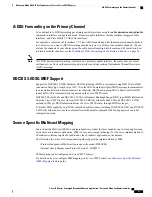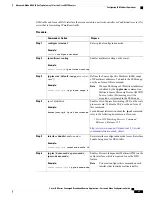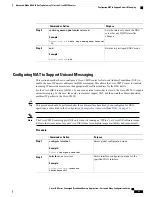
A-DSG Forwarding on the Primary Channel
You can disable A-DSG forwarding per primary capable interface using the
cable downstream dsg disable
command in interface configuration mode. Primary capable interfaces include modular, integrated cable
interfaces, and Cisco cBR-8 CCAP cable interfaces.
For example, assume the cable interface 7/1/1 has A-DSG enabled and has four modular channels attached
to it. However, you want A-DSG forwarding enabled only on two of these four modular channels. You can
exclude the channels of your choice using the cable downstream dsg disable command. For details on how
to disable modular channels, see the
Disabling A-DSG Forwarding on the Primary Channel, on page 28
.
If A-DSG downstream forwarding is disabled on a primary capable interface, the router does not create
multicast service flows on the primary capable interface and stops sending Downstream Channel Descriptor
(DCD) messages.
Note
DOCSIS 3.0 DSG MDF Support
Support for DOCSIS 3.0 DSG Multicast DSID Forwarding (MDF) is introduced using DSG DA-to-DSID
Association Entry type, length, value (TLV 13) in the MAC domain descriptor (MDD) message to communicate
the association between a downstream service identifier (DSID) and a group MAC address used for DSG
tunnel traffic. This is automatically supported on the Cisco CMTS router.
DOCSIS 2.0 hybrid CMs and DOCSIS 3.0 CMs use Dynamic Bonding Change (DBC) to get DSID information
from the Cisco CMTS router, whereas DOCSIS 2.0 DSG hybrid embedded CMs and DOCSIS 3.0 DSG
embedded CMs get DSID information from the Cisco CMTS router through MDD messages.
To disable MDF capability on all DSG embedded cable modems, including DOCSIS 3.0 DSG and DOCSIS
2.0 DSG hybrid modems, use the cable multicast mdf-disable command with the dsg keyword in global
configuration mode.
Source Specific Multicast Mapping
Source Specific Multicast (SSM) is a datagram delivery model that best supports one-to-many applications,
also known as broadcast applications. SSM is a core networking technology for the Cisco implementation of
IP multicast solutions targeted for audio and video broadcast application environments.
The following two Cisco IOS components together support the implementation of SSM:
•
Protocol Independent Multicast source-specific mode (PIM-SSM)
•
Internet Group Management Protocol Version 3 (IGMPv3)
SSM mapping can be configured on Cisco CMTS routers.
For details on how to configure SSM mapping on a Cisco CMTS router, see the
feature guide.
Cisco cBR Series Converged Broadband Routers Application
—
Voice and Video Configuration Guide
13
Advanced-Mode DOCSIS Set-Top Gateway 1.2 for the Cisco CMTS Routers
A-DSG Forwarding on the Primary Channel




































